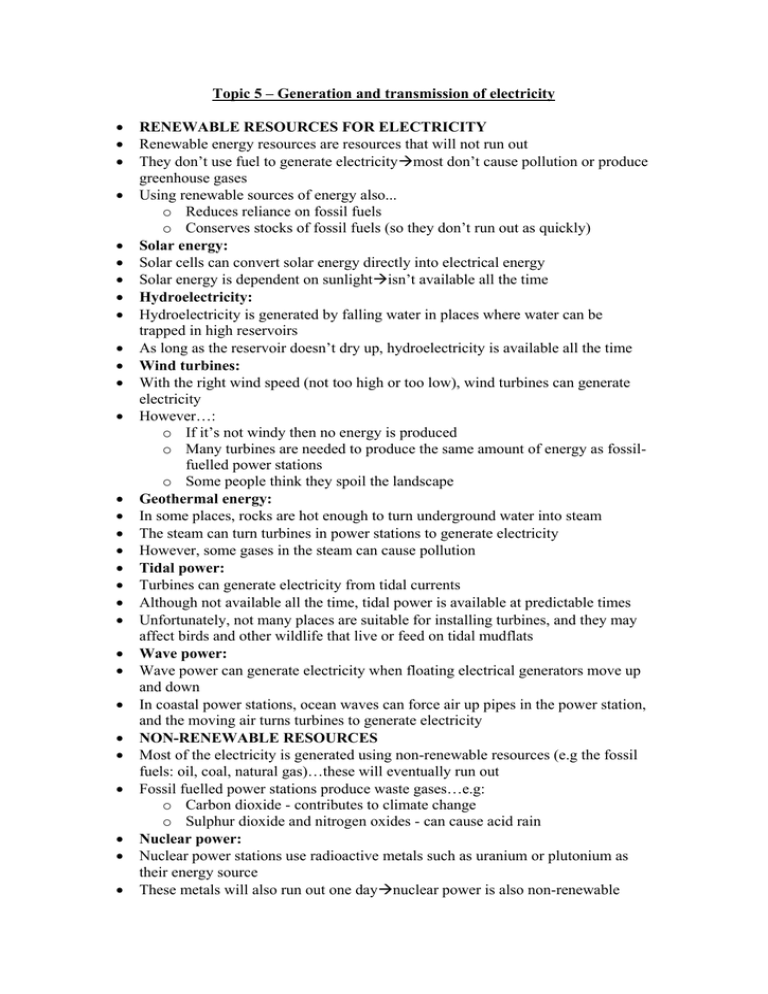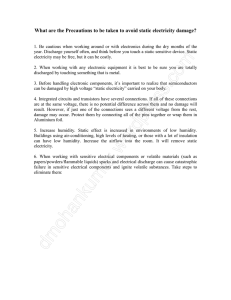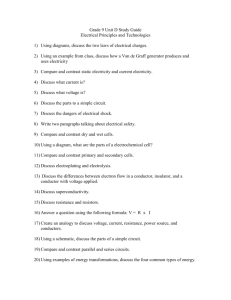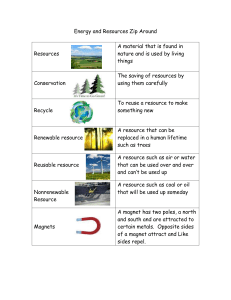Topic 5 notes - Greenacre Academy Trust
advertisement

Topic 5 – Generation and transmission of electricity RENEWABLE RESOURCES FOR ELECTRICITY Renewable energy resources are resources that will not run out They don’t use fuel to generate electricitymost don’t cause pollution or produce greenhouse gases Using renewable sources of energy also... o Reduces reliance on fossil fuels o Conserves stocks of fossil fuels (so they don’t run out as quickly) Solar energy: Solar cells can convert solar energy directly into electrical energy Solar energy is dependent on sunlightisn’t available all the time Hydroelectricity: Hydroelectricity is generated by falling water in places where water can be trapped in high reservoirs As long as the reservoir doesn’t dry up, hydroelectricity is available all the time Wind turbines: With the right wind speed (not too high or too low), wind turbines can generate electricity However…: o If it’s not windy then no energy is produced o Many turbines are needed to produce the same amount of energy as fossilfuelled power stations o Some people think they spoil the landscape Geothermal energy: In some places, rocks are hot enough to turn underground water into steam The steam can turn turbines in power stations to generate electricity However, some gases in the steam can cause pollution Tidal power: Turbines can generate electricity from tidal currents Although not available all the time, tidal power is available at predictable times Unfortunately, not many places are suitable for installing turbines, and they may affect birds and other wildlife that live or feed on tidal mudflats Wave power: Wave power can generate electricity when floating electrical generators move up and down In coastal power stations, ocean waves can force air up pipes in the power station, and the moving air turns turbines to generate electricity NON-RENEWABLE RESOURCES Most of the electricity is generated using non-renewable resources (e.g the fossil fuels: oil, coal, natural gas)…these will eventually run out Fossil fuelled power stations produce waste gases…e.g: o Carbon dioxide - contributes to climate change o Sulphur dioxide and nitrogen oxides - can cause acid rain Nuclear power: Nuclear power stations use radioactive metals such as uranium or plutonium as their energy source These metals will also run out one daynuclear power is also non-renewable Nuclear power stations don’t emit any carbon dioxide or other gases However, the waste they produce is radioactiveit must be sealed into concrete or glass and buried safely so that the radioactivity cannot damage the environment A nuclear power station also needs to be dismantled carefully when closing down so that no radioactive materials escape into the environment These safety considerations make nuclear power stations more expensive to build and dismantle than fossil-fuelled power stations There aren’t many accidents as the stations are designed to contain any radioactive leaks However, when major accidents occur, they have very serious consequences (e.g Chernobyl, 1986) Advantages of fossil fuels and nuclear power (compared to renewable resources): At the moment there is still good supply of both fossil fuels and nuclear fuel They produce electricity more cheaply They don’t depend on the weather or the tideselectricity is available all the time GENERATING ELECTRICITY Electricity is a flow of charged particles Current is the rate of electrons flowing in a circuit Voltage is a measure of the amount of energy transferred by the electrons to an electric component Induced current: If you move a piece of wire in a magnetic field, an electric current will flow in the wire This process is called electromagnetic induction and a current produced in this way is called an induced current The size of the induced current can be increased by: o Putting more turns on the coil of wire o Using an iron core inside the coil of wire o Using stronger magnets o Moving the wire faster The direction of the current can be changed by…: o changing the direction of movement of the wire o changing the direction of the magnetic field (i.e by swapping the poles of the magnet) To create a continuous induced current, you must keep the magnet moving relative to the coil of wire Direct current vs alternating current: Direct current – current always flows in the same direction (i.e it’s either positive or negative) Alternating current – current changes direction (i.e both positive and negative) Dynamos and generators: Simple dynamos (used in bicycle lights and wind-up torches and radios) produce direct current Generators are used to produce electricity on a larger-scale...: o Electricity induced in the coil is transferred to a circuit through slip rings and connected carbon brushes o The slip rings and carbon brushes allow electricity to flow without the wires becoming twisted o Each side of the coil goes up through the magnetic field and then down againthe direction of the induced current changes o generators produce alternating current Generators in power stations need to induce a very high voltage…: o Strong permanent magnets are very expensivegenerators often use electromagnets instead o Electromagnets are able to create much more powerful magnetic fields than permanent magnets PAYING FOR ELECTRICITY Joule (J) – unit of measurement for energy Power: the amount of energy that is used by a working appliance each second Unit of measurement for power is joule/second (J/s) or watt (W) 2 equations: o Power (watt, W) = energy used (joule, J) / time (second, s) o Power (watt, W) = current (ampere, A) x voltage (volt, V) Many electrical appliances need a lot of powerusually their ‘power rating’ (showed on the appliance) is given in kilowatts (kW)……1 kW = 1000W Electricity companies charge for electrical energy by the kilowatt-hour (kWh)… o 1 KwH is the amount of energy that’s transferred by a 1 kW device in 1 hour The cost of electricity is worked out using the formula…: o Cost (pence, p) = power (kilowatt, kW) x time (hour, h) x cost of 1 kWh (p/kWh) o E.g an electric heater has a power rating of 2kW. What is the cost of using the fire for 3 hours if 1 kWh of electricity costs 12 p? Cost = 2 x 3 x 12 = 72 p TRANSMITTING ELECTRICITY Electricity is sent from power stations to homes, schools and factories by a system of wires and cables called the National Grid The National Grid: 1. Power stations produce alternating currents with voltages around 25,000V 2. Before the electricity is sent around the country, step-up transformers are used to increase the voltage to 400,000V: o When electricity passes through wires (along transmission lines), energy is lost as heat o Increasing the voltage of the electricity passing along transmission lines reduces the current (current = power / voltage)less energy is wasted as heatefficiency is improved 3. After passing along transmission lines, step-down transformers in local substations reduce the voltage to about 230V for homes and schools – this is necessary for safety reasons Transformer calculations: Transformers consist of two coils of insulated wire wound onto an iron core The voltage produced or the number of turns required by a transformer can be calculated by: o Voltage (primary coil) / voltage (secondary coil) = turns (primary coil) / turns (secondary coil) o E.g radio runs off mains supply (230V) but only needs 23V supply. If the transformer has 100 turns of wire on primary coil, how many turns are needed on the secondary coil? 230V – voltage (primary coil) 23V – voltage (secondary coil) 100 – turns (primary coil) turns (secondary coil) = (23x100)/230 = 10 turns Hazards associated with electricity transmission: If one part of your body is at a higher voltage than another (e.g if you fly a kite on electric cables), electric current runs through youyou get an electric shock Birds sitting on electricity transmission lines don’t get a shock because both of their feet are on the wire at the same voltage (no voltage imbalance) REDUCING ENERGY USE Electricity is mostly generated by the burning of fossil fuels, which releases CO2 and other harmful gasescontributing to climate change Reducing energy use reduces the amount of CO2 (and other gases) added to the atmosphere and also saves money on electricity bills Reducing energy use in the home – e.g double glazing, solar panels... Cost efficiency of these methods: o All these methods of reducing energy usage in the home cost money o The length of time it takes you to save the amount of money it costs to buy the item is called the ‘payback time’…: Payback time = cost / saving per year The shorter the payback time, the more cost-efficient the method (i.e lower cost and greater saving per year)


